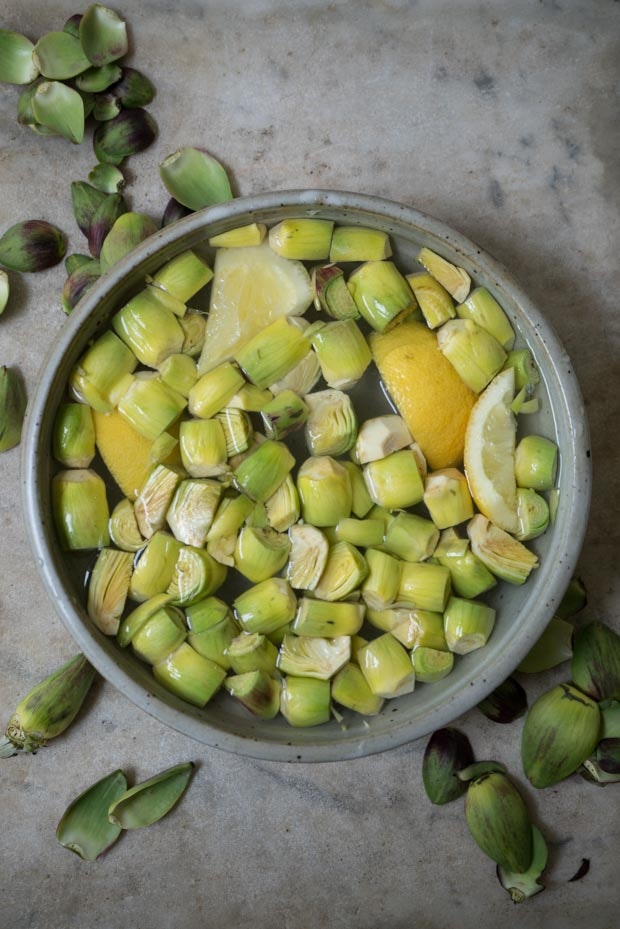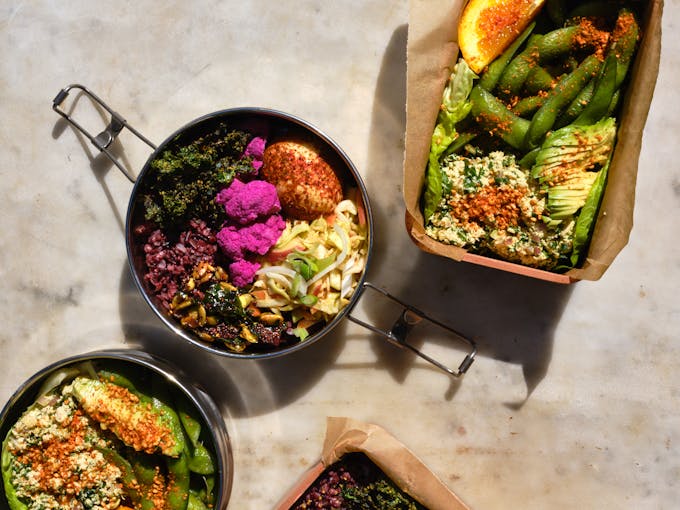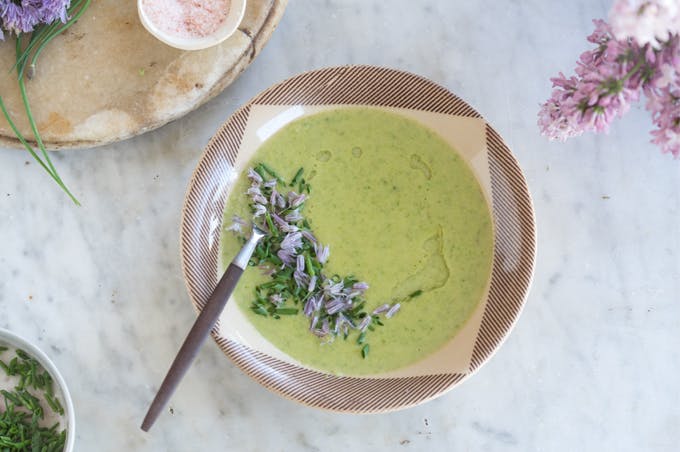A Few Words on How to Cook Artichokes
A primer on how to cook artichokes, particularly the baby ones. A lot of people are intimidated by the process, or they think it's not worth the effort. But with a little patience, salt, and fat - you can absolutely cook some of the best artichokes of your life.

This is a primer on how to cook artichokes - if you're going to invest the time into cooking artichokes, you want them to be fantastic. Spring is the time I tend to cook them once or twice a week. And, although the process takes time and attention, I can't help myself. When artichokes are good, there are few things I'd rather be eating. 
Straight up, I think a lot of people are intimidated by the idea of cooking artichokes, or they think it's not worth the effort. My friends confirm this. The topic has come up a few times lately, and the conversations are typically punctuated by a confession that they never cook artichokes at home.
So(!) I thought I'd do a quick outline of how I handle these armored spring ambassadors. Eight times out of ten I use the cooking method I'm going to outlined in the recipe section below. It requires nothing more than good (baby) artichokes, olive oil or clarified butter, and sea salt. If you can pair those ingredients, with a bit of practice, a hint of patience, and a window of time, you can absolutely cook some of the best artichokes. Not kidding. Once you hit your groove with these wondrous thistles, few of you will look back.
A Case For Cooking Artichokes
Nutritionists celebrate artichokes for a long list of reasons. They're packed with fiber, antioxidants, and phytonutrients, and have long been known to support the liver. They don't get as much of the limelight as other ingredients - for example pomegranate, turmeric, acai, etc. - but they bring quite a lot to the table. It's worth incorporating them into your meals, particularly when they're in season.
A Worthwhile Shortcut
Update(!): I recently discovered frozen bags of artichokes at a local Trader Joes, and started experimenting to see if using them would be a worthwhile substitute to using fresh artichokes. At the very least, this could be a way to extend artichoke season. I don't love canned or jarred artichokes, and it turns out, the frozen option is pretty great. You can cook them in a covered skillet in a bit of olive oil, straight from the freezer, until they're cooked through, and then remove the cover and dial up the heat to get some nice, golden color on them. Season and serve. So good!
And lastly, I've been using leftover pan-blistered artichokes and a component in my on-the-go lunches. Here's where you can see them along with other feel-good lunch ideas.
How to Cook Artichokes
More times that not, this is how I like to prepare artichokes. The method works for whatever artichokes look good at the market - baby artichokes are ideal. The gist is - trim, blanch, saute. You end up with beautiful, tender, succulent, golden-crusted artichoke hearts that can be enjoyed straight from the pan, or in any number of other preparations - I outline a few below.
- Artichokes
- 1 lemon
- Extra virgin olive oil or clarified butter
- sea salt
-
Fill a bowl with water, squeeze the juice of the lemon into it. You'll add the artichokes to the water immediately after trimming.
-
To trim your artichokes: Actually, before I get into the details of trimming, let's just establish what we're after. We're after the tender. Meaning, we want to trim any tough outer leaves, tips, and stem. We want to get down to the tender parts of the leaves, without trimming so much that we have little left. To start, trim the stem. Pull the outer leaves from the artichoke, until you get down to the more tender leaves. Cut off the top of the artichoke (roughly where it begins to taper in), you want to remove the tough part of the tips. I like to use a serrated knife for that cut. From here decide what shape you'd like your artichoke pieces to be. For this preparation, I cut each artichoke in halves, and/or quarters. If you are using larger artichokes, ones that have developed a fuzzy choke, you'll need to use a teaspoon (or mellon baller) to carve the fuzz out before moving on to your final cuts. Work efficiently, and get the trimmed artichokes in the lemon water as quickly as possible to reduce browning from oxidation.
-
While prepping the artichokes, bring a medium saucepan of water to a boil. Salt well, and use a slotted spoon to transfer them from the lemon water to the boiling water. Boil until just tender, typically a minute or two. Drain well, and set aside. Alternately, you can steam the artichokes - this will keep more of the nutrients intact. Either way, you want the artichokes to be cooked tender (and feel free to eat them at this point)!
-
I can't resist a bit of crust and crunch to them, so... Heat a tablespoon of oil or clarified butter in a large saucepan over medium high heat. When hot, transfer the artichokes to the pan in a single layer. Toss to coat, and add a pinch or two of salt. Allow to saute, tossing every few minutes, until the artichokes are deeply golden and crusted.
-
You can enjoy these immediately, or at room temperature, or you can save them for a few day, refrigerated, in a coating of olive oil (drain before using)....
A few other notes:
Buying Artichokes: Your success here is going to depend on sourcing good artichokes. Look for tight, dense examples. This is a sign that they have been recently harvested. If you see the leaves have started to flower out, separate, or dry out, give them a pass.
Storage: Store artichokes in a bag in your refrigerator until ready to use. That said, try to use them quickly - within few days of purchase. The sooner the better.
Add-ins: This technique makes beautiful artichokes in their own right, but occasionally I like to flare them out with other things I have on hand. they have a great affinity for olives, orange zest, chopped almonds, chile flakes, fennel, anise, and lemon oil.
Great-on: Once you have a skillet of these, you can eat them on their own, or use them in/on all sorts of things. This artichoke season I've had them on farro risotto, quinoa, frittata, pureed cauliflower soup, and chopped into a ravioli filling. As I'm typing this, I'm imagining they'd be amazing as a component in a dumpling filling, or spring roll.









Post Your Comment
Comments
Mostly I just love that you've named them "armored spring ambassadors." :)
Thank you for this post!!! I have six artichoke plants that are teeming with artichokes and they can be a bear to cook properly. I have a pasta thing I wanna make and this looks like the perfect way to cook them. Love the sauté at the end.
Lovely post, Heidi. I'm looking forward to trying your cooking technique. One artichoke affinity that you neglected is GARLIC. As a 3rd generation Califoria Artichoke eater, I'm used to adding chopped garlic to the cooking water. Yum! With your version, it could be sautéed along with the chokes. Thanks as always, Heidi
Thanks Heidi. The tea is a revelation - what an idea! My liver could use it after prolonged and enthusiastic celebration of the return of Rose weather
I'll try this! Thank you for your awesomeness, Ms. Swanson. Definitely one of my favorite sites! I winnowed down my email subscription recently; of course, you weren't chopped! Looking forward to the book Near & Far.
thank you for both the detailed explanation, and the pictures - being able to see the outcome of each step is very useful!
Wait, I see all those leaves torn off and left aside - do you not eat them by biting off the tender bit towards the stem? Especially as a vehicle for melted butter? I can see thais prep if you have alot of smaller arty-chokes (does anyone remember-might choke Arty but it won't choke Stymie). I have two large (LARGE) globes sitting in the fridge waiting for tonight. I can't imagine throwing away a better portion of them by stripping the leaves off for just the two centers. Do you treat the big boys differently?
HS: Sometimes! I also like to boil the leaves into a nutritious tea, or broth, or use that as a sauce component. You can always steam the big globes, and then take the dunk and scrape approach.
This is the perfect! I have been waiting for a post on artichokes. Lovely! I am so looking forward to trying this. My daughter has hated most vegetables, but has always loved artichokes. I think having options cooking them is wonderful.
Can't wait to try the blanching first. It sounds like the perfect thing for artichoke lasagna.
You are so right. Artichokes are intimidating to cook for many, I will admit to only cooking them once in a blue moon. The first I tried was in Colombia, where I'm from, and had no idea what to expect. Ended up tossing it out because I couldn't figure it out! Thanks for the advise!
I think the very best way to cook artichokes that you intend to eat without stripping the leaves (i.e. eating one leaf at a time dipped in melted butter) is to use a pressure cooker. The flavor is kept in the cooker and you get a bigger burst of artichoke flavor. Yummy.
I LOVE artichokes but have never had any luck with fresh ones......I just can't figure them out. I recently found frozen artichokes and I'm in heaven. Much better than canned. I'm thinking I know what is for dinner tonight.
Thanks so much for this outline! Would love to read something similar for other slightly more complicated, not so intuitive, yet versatile ingredients. In Shanghai, where I am for a few months before returning to the Bay Area, my local market has a lot of daikon radishes, yam leaves, and king trumpet mushrooms. Can't wait for next spring's artichokes!
I usually cook the artichokes whole in boiling water with lemon & lemon juice and salt so it would be nice to cook them differently for a change. I just bought 8 artichoke at Trader Joe's, here in Los Angeles, for a great price ($1 per large beautiful artichoke). Good post! Thanks
Such gorgeous photographs. But then, I'm a sucker for a pretty carciofo. But I have a question: why do you blanch them first? In Italy this is never done. Is it because the artichokes are a bit tougher in the States? I'm curious, because I never quite know what type of artichokes people are using when making my recipes.
HS: Good morning lovely Elizabeth! I like to blanch them for the texture - it lends a silky, succulent, tenderness that I just can't get with a straight saute...More of a personal preference than anything?
Don't toss the stem....it's the best part! Try either leaving it on or chopping it off and incorporating into the final batch. Delicious!
Thanks for sharing! I've never prepared them myself and have been wanting to. I agree with Laura, I always order anything that contains artichoke when dining out but now I feel capable making them at home!
So glad you posted this! Cooking artichokes is one of those very intimidating things for me, although I love them. When ordering at a restaurant, I always try to get a dish with artichokes incorporated in them because I love them so much......just can't cook myself. Always get a little sad when seeing "chokes" in the grocery store thinking to myself....hmmmm....would love to eat those just don't know how to prepare =) Now I do! yay.
Omg thank you for this! I love artichokes but never knew how to prepare them properly. It no longer seems that daunting (: Saving this post! xo Jia
Thank You so much Heidi! I am determined and have a bag of beautiful baby chokes already waiting in the fridge... -Erin